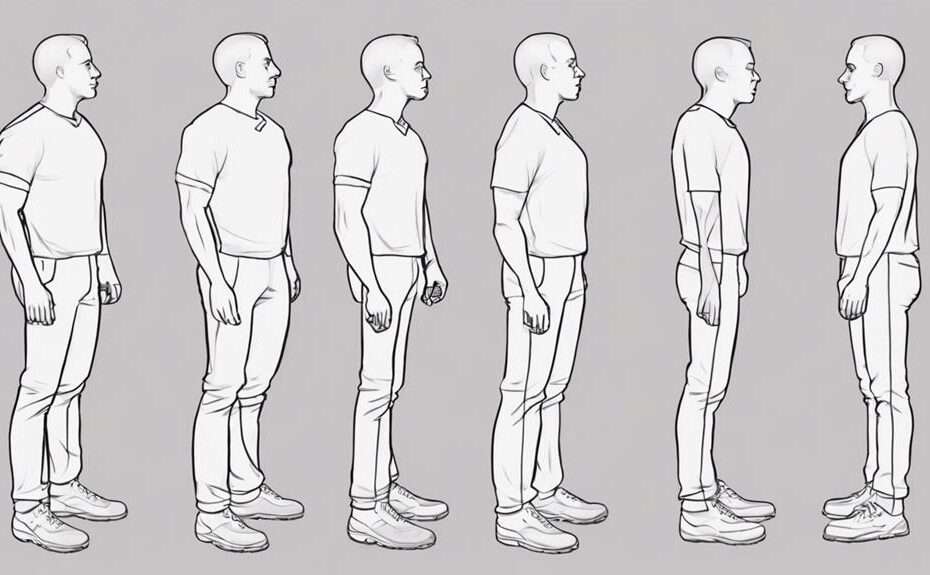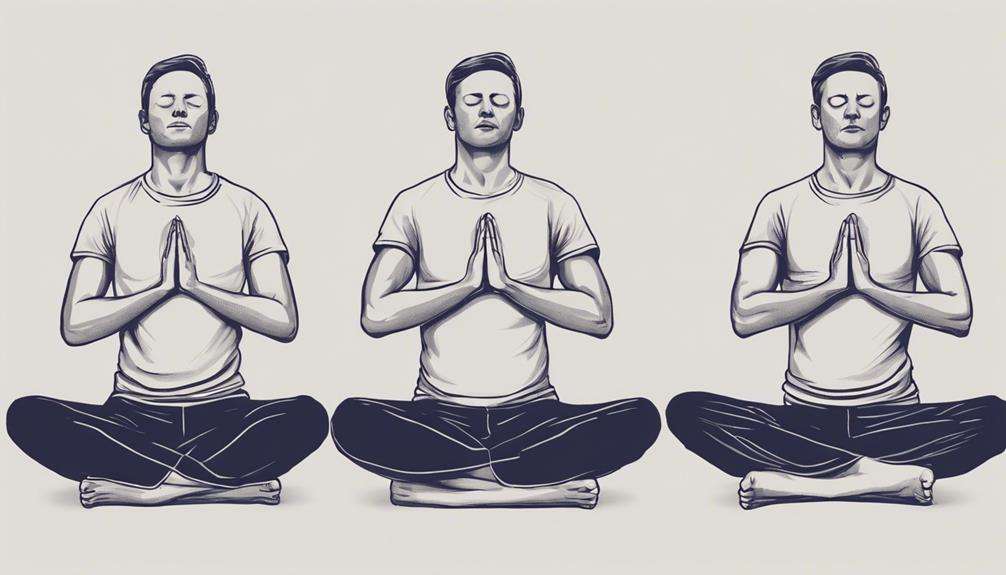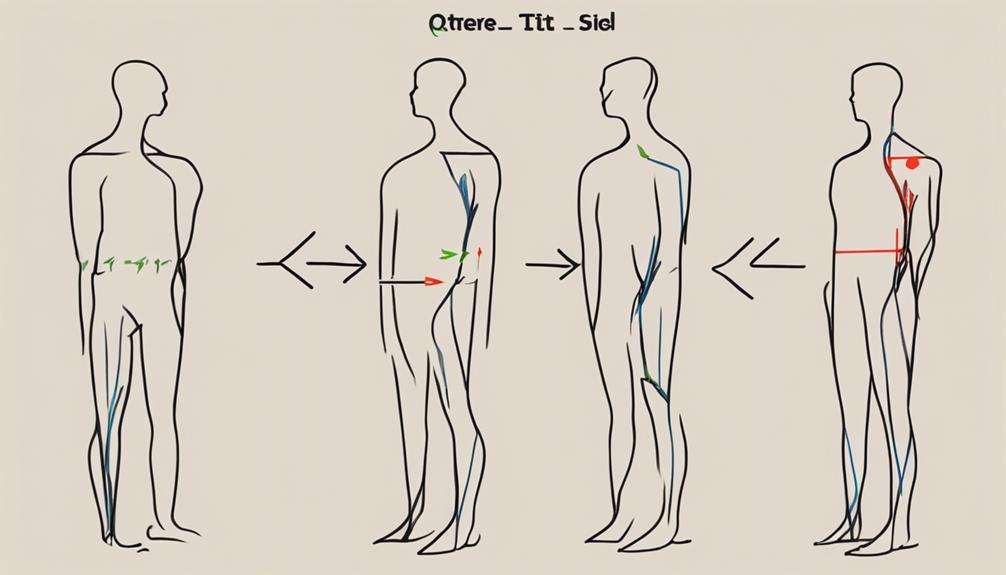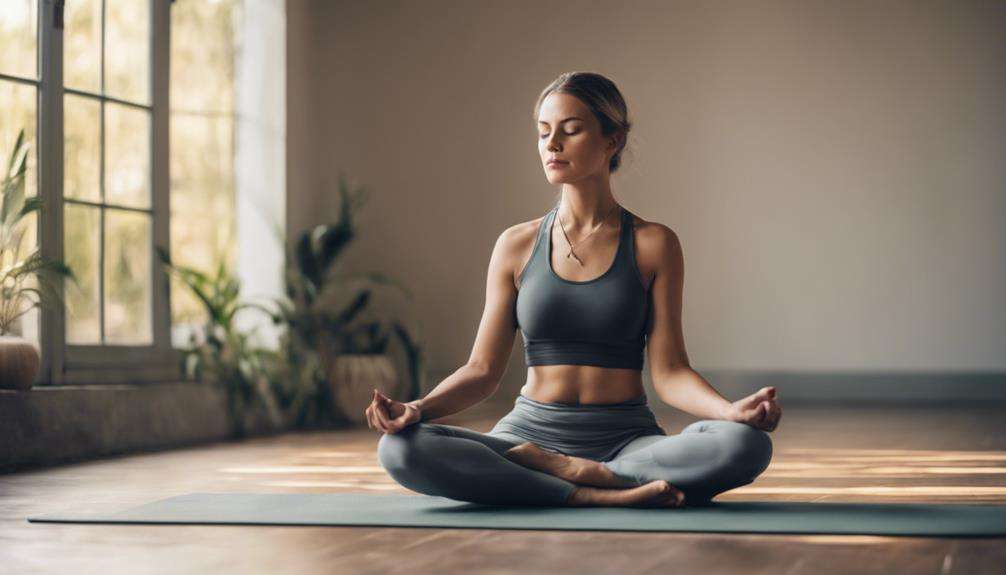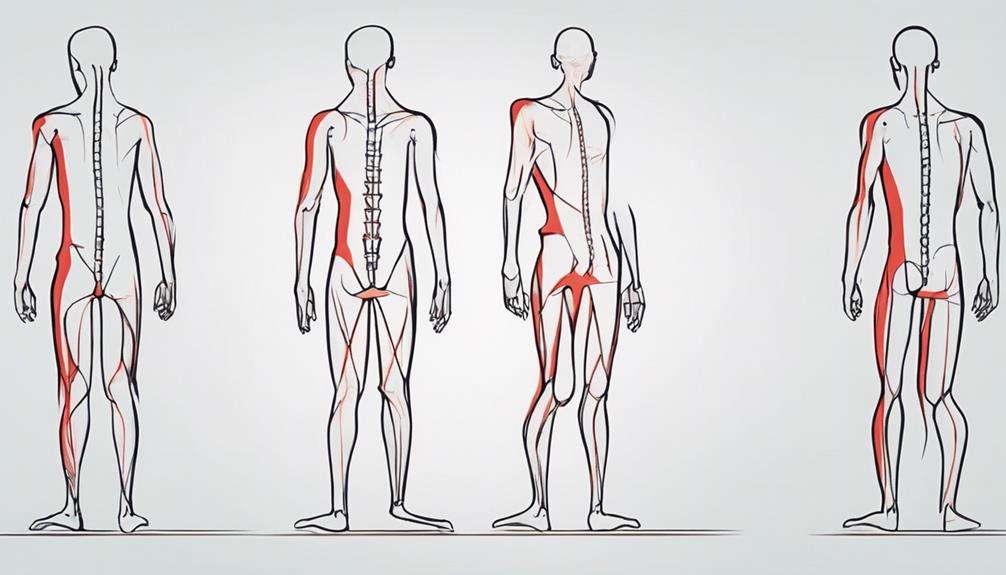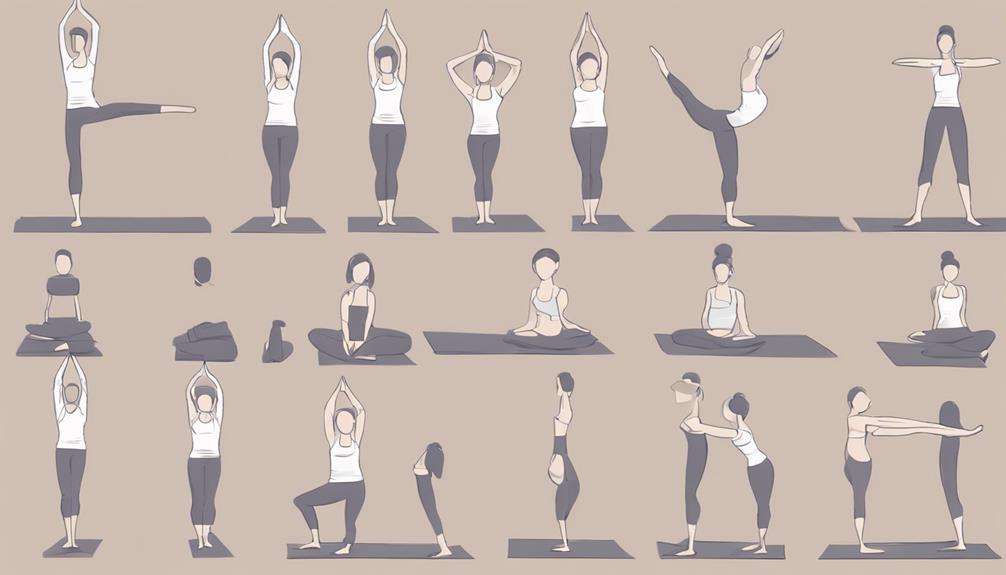Imagine your body as a finely tuned instrument—a symphony of muscles, bones, and ligaments working in harmony. Now, think about how certain poses can be the conductor, guiding each part into perfect alignment.
But which poses hold the baton to lead you towards better posture? Let's explore together the key poses that can sculpt your body into a masterpiece of alignment and grace.
Key Takeaways
- Mountain Pose (Tadasana) promotes alignment and awareness for better posture.
- Shoulder Opener Poses enhance shoulder mobility crucial for maintaining good posture.
- Bridge Pose strengthens the back and core muscles, aiding in posture correction.
- Eagle Pose (Garudasana) improves balance, strength, and overall body alignment for better posture.
Mountain Pose
To achieve better posture and enhance your overall body awareness, incorporating the Mountain Pose, also known as Tadasana, into your regular routine can be highly beneficial. This foundational yoga pose focuses on aligning your entire body, from head to toe, with feet hip-width apart and shoulders stacked over hips. By engaging your core muscles in Mountain Pose, you can strengthen your thigh muscles, improve posture, and promote greater body awareness.
Mountain Pose plays an important role in correcting alignment issues, lengthening the spine, and enhancing balance and stability. Regular practice of Tadasana can help you cultivate a sense of groundedness, improve posture, and reduce the risk of musculoskeletal imbalances. By emphasizing proper spinal alignment, leg and core strength, this pose fosters a feeling of alignment and poise throughout your body. Incorporating Mountain Pose into your yoga routine can contribute significantly to your overall posture and well-being.
Shoulder Opener
Shoulder opener poses in yoga are essential for improving flexibility and mobility in the shoulders, chest, and upper back. These poses, such as Eagle Arms or Cow Face Pose, specifically target the muscles around the shoulders and chest, helping to stretch and release tension in these areas. By incorporating shoulder opener poses into your routine, you can greatly enhance your posture by countering the effects of poor posture that often lead to rounded shoulders and hunching forward.
Regular practice of shoulder opener poses can greatly enhance your posture by enhancing upper body alignment and strengthening the muscles that support proper posture. By opening up the chest and reaching the shoulder blades back and down, these poses help prevent the development of postural issues that can cause discomfort and pain in the shoulders and neck. Embracing shoulder opener poses as part of your yoga practice can contribute to a healthier and more aligned upper body, ultimately supporting your overall posture and well-being.
Cat-Cow Stretch
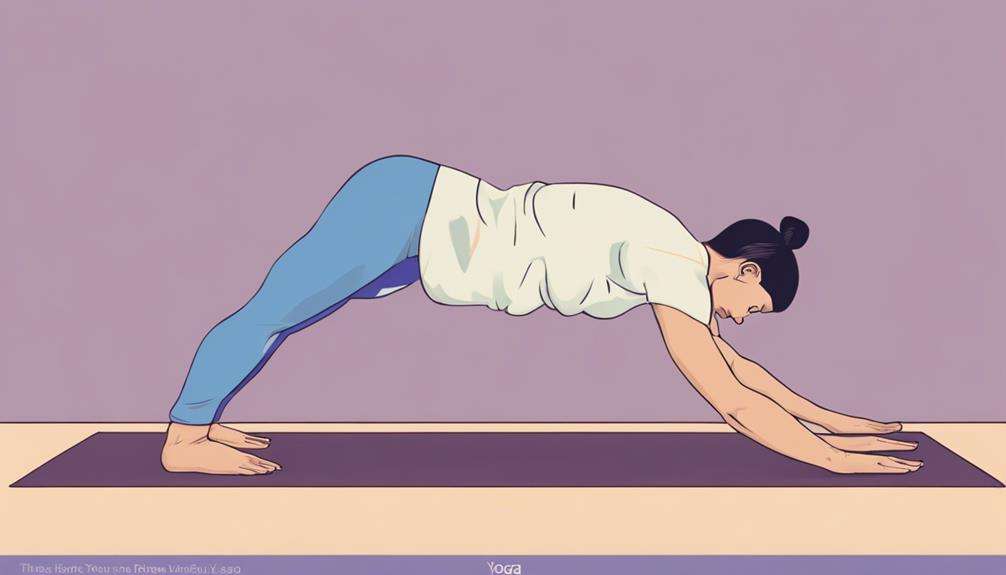
Embracing the Cat-Cow Stretch in your yoga routine can greatly improve spinal flexibility and alignment while countering the effects of prolonged sitting or slouching.
This dynamic yoga pose involves arching and rounding the spine, helping to increase spinal mobility and relieve tension in the back, neck, and shoulders.
By engaging the core muscles and promoting better posture, the Cat-Cow stretch enhances body awareness for proper alignment, making it an essential exercise for overall spinal health.
The rhythmic movement of this stretch not only increases flexibility but also reduces the risk of back pain associated with poor posture.
Regular practice of the Cat-Cow stretch can prevent stiffness and discomfort, allowing for a healthier spine.
Incorporating this pose into your daily routine won't only improve your posture but also contribute to a more flexible and pain-free back.
Bridge Pose
Incorporate Bridge Pose into your routine to strengthen key muscles essential for maintaining good posture and promoting overall body alignment. This pose targets the back, glutes, and hamstrings, which are important for supporting the spine and keeping it in proper alignment. By engaging these muscle groups, Bridge Pose helps to improve posture by addressing weaknesses or imbalances in these areas.
Additionally, this pose opens up the chest and shoulders, counteracting the effects of slouching and poor upper body posture. Strengthening these areas can help prevent rounded shoulders and promote a more upright position. In addition, Bridge Pose engages the core muscles, enhancing spinal stability and alignment.
Eagle Pose
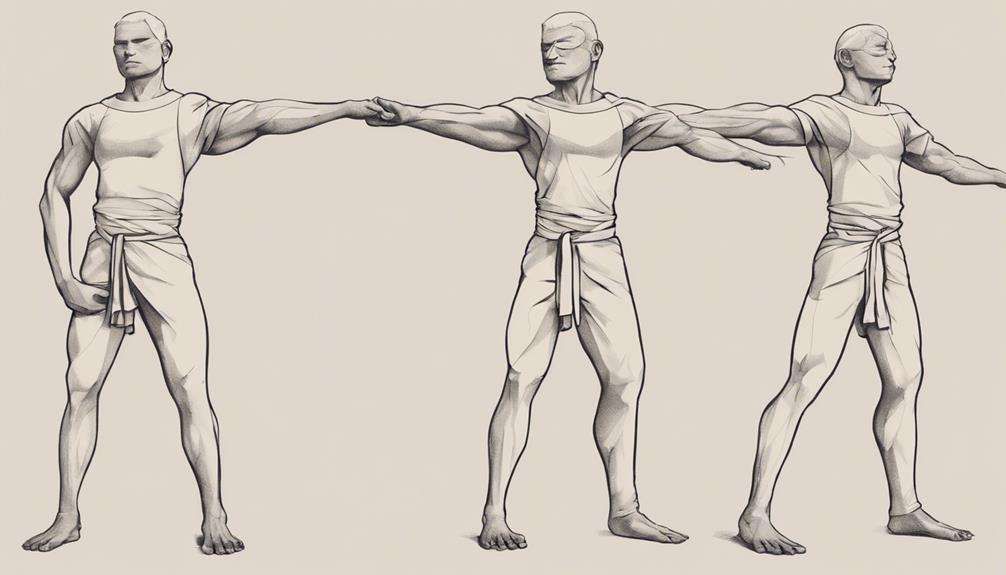
When practicing yoga for posture improvement, engaging in Eagle Pose can effectively strengthen key muscle groups and enhance overall body alignment. Eagle Pose, also known as Garudasana, targets the ankles, calves, thighs, and hips, providing a thorough workout for these areas. This pose not only strengthens muscles but also improves balance and focus while stretching the shoulders and upper back. By squeezing the legs and arms together in Eagle Pose, you engage your core muscles, which are essential for maintaining good posture.
Additionally, Eagle Pose helps open up the back, shoulders, and hips, further enhancing body alignment. Regular practice of this pose can relieve tension in the shoulders and upper back, contributing to better posture overall. The combination of strength-building, stretching, and alignment work in Eagle Pose makes it a valuable addition to any posture improvement routine. Whether you're looking to strengthen your core muscles, improve balance, or find tension relief, incorporating Eagle Pose into your yoga practice can be highly beneficial.
Plank Pose
Plank Pose effectively strengthens core muscles important for maintaining good posture and enhancing overall body alignment. By engaging in Plank Pose, you aren't only working on your core strength but also improving spinal alignment and stability. This foundational yoga pose is a powerhouse for activating the muscles that support proper posture and alignment throughout the body. Holding the Plank Pose for just 20-30 seconds can already start yielding posture benefits.
Regularly practicing Plank Pose can greatly contribute to enhancing your overall body posture. The muscles activated during this pose help in keeping your spine aligned and stable, which are critical elements for good posture. By strengthening your core through Plank Pose, you're providing a solid foundation for better posture in your daily activities. Incorporating this pose into your routine can be a simple yet effective way to work on your posture and promote better alignment in your body.
Shoulder Stand
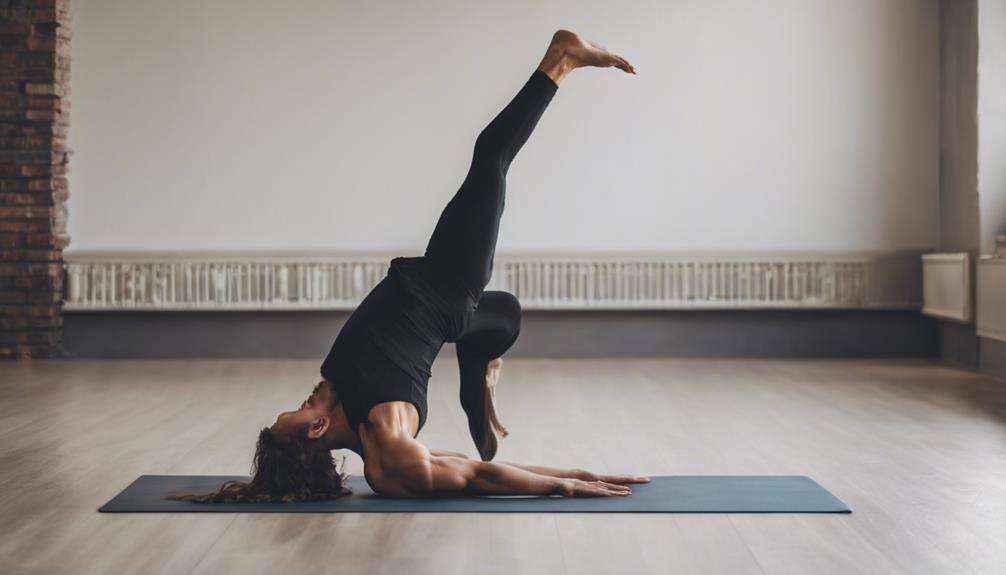
To enhance your posture and strengthen key muscles, consider practicing the Shoulder Stand yoga pose regularly. Shoulder Stand is an inverted yoga pose that offers a range of benefits. This pose not only strengthens the shoulders and neck muscles but also elongates the spine, aiding in improving posture and alignment. By practicing Shoulder Stand, you can stimulate the thyroid gland, enhance blood circulation to the brain, and even improve digestion. Additionally, this inverted yoga pose can help relieve stress and fatigue while promoting a sense of calm and relaxation.
Regularly incorporating Shoulder Stand into your yoga routine can contribute to maintaining a healthy spine and supporting better overall posture. The benefits of this pose extend beyond just physical aspects; they also encompass mental well-being. So, the next time you're on the mat, remember to include Shoulder Stand to reap the rewards of this beneficial inverted yoga pose.
Tiger Pose
Strengthen your core muscles essential for good posture with the Tiger Pose, a yoga position that also enhances balance, stability, and flexibility. This dynamic pose not only targets the core but also works on improving balance and stability throughout the body.
By stretching the spine and hip flexors, the Tiger Pose enhances flexibility, promoting a greater range of motion. Additionally, practicing this pose increases body awareness and focus, allowing you to align your body more effectively.
Regularly incorporating the Tiger Pose into your routine can help you maintain a strong and aligned posture, reducing the risk of slouching or other postural issues. Remember to engage your core muscles and focus on your breathing while holding the pose to maximize its benefits.
Embrace the Tiger Pose to fortify your core, enhance your balance, and cultivate a more aligned posture.
Cow Face
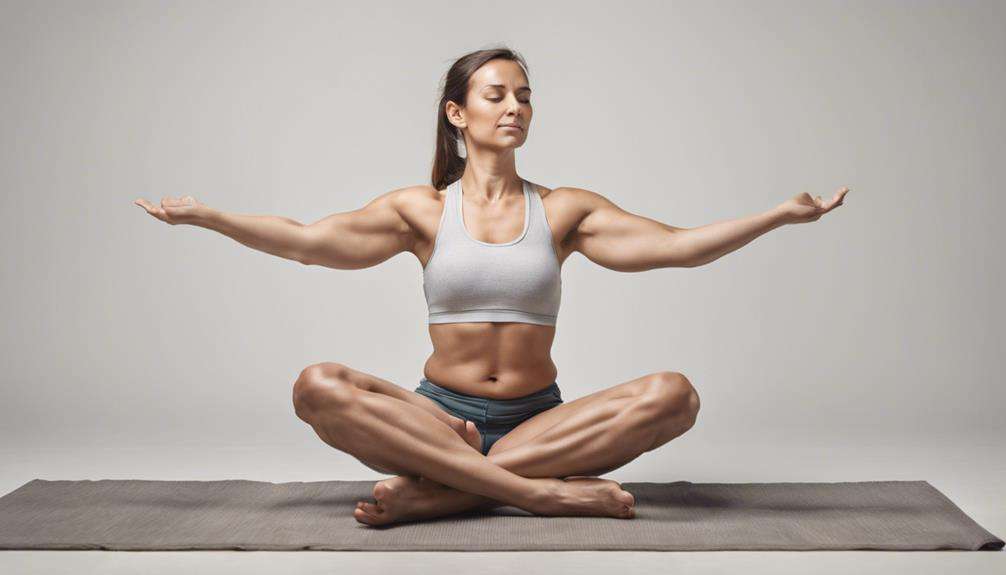
Cow Face Pose is a beneficial yoga posture that targets the shoulders, arms, and chest to enhance your posture.
By opening up the chest and releasing upper body tension, Cow Face Pose can improve shoulder flexibility and strengthen the upper back muscles.
Regular practice of this pose not only aids in better posture but also helps in reducing neck and shoulder tension, leading to improved focus and overall well-being.
Benefits of Cow Face
By incorporating Cow Face Pose into your routine, you can enhance upper body flexibility and correct postural imbalances that may lead to stiffness and discomfort.
This pose specifically targets the shoulders, arms, chest, and triceps, improving flexibility in the upper body. It helps address issues like rounded shoulders and a hunched posture by opening up the chest and shoulders, promoting better alignment.
Cow Face Pose also aids in releasing tension in the upper back and neck, which can contribute to overall stiffness. Additionally, practicing this pose regularly can enhance spine flexibility, preventing stiffness in the shoulders and upper back.
How to Do Cow Face
To perform Cow Face Pose (Gomukhasana), start by sitting with your legs stacked and knees aligned. Then reach one arm up and the other behind your back to clasp your hands. Engage your core muscles, lengthen your spine, and gently lift your chest to open your shoulders for better alignment.
This pose stretches your shoulders, arms, and chest, enhancing flexibility and relieving tension, which contributes to improved posture. Regular practice of Cow Face Pose can increase body awareness, correct rounded shoulders, and help maintain proper spinal alignment.
Cobra Pose
Strengthen your back muscles and improve your posture with the beneficial Cobra Pose, a yoga position known for its ability to enhance spinal support and alignment. This pose targets the back muscles, particularly the erector spinae, which play a crucial role in supporting the spine and maintaining proper posture. By engaging these muscles, Cobra Pose helps prevent slouching and promotes a more upright stance.
Additionally, this pose stretches the chest and abdomen, counteracting the effects of poor posture habits like hunching. Cobra Pose can also relieve tension in the shoulders and upper back, areas that commonly hold stress and contribute to postural imbalances.
Furthermore, by opening up the chest and shoulders, Cobra Pose enhances breathing mechanics, allowing for deeper breaths and increased awareness of posture. Regular practice of Cobra Pose can aid in preventing rounded shoulders, leading to a more balanced and aligned posture overall.
Frequently Asked Questions
What Yoga Pose Teaches Correct Posture?
Mountain Pose is the yoga pose that teaches correct posture by aligning your body from head to toe. It strengthens core muscles, improves body awareness, and encourages proper spinal alignment, fostering good posture habits.
How Can I Get Perfect Posture Fast?
To improve your posture fast, focus on posture exercises, tips, alignment, stretches, support, correction, and habits. Engage in yoga poses like Mountain Pose, Cat-Cow Stretch, and Downward Dog, ensuring proper form and consistency for rapid results.
Can Yoga Fix Bad Posture?
Yoga benefits your posture alignment by strengthening muscles, supporting spinal health, and enhancing core stability. This practice fosters a mind-body connection and provides flexibility training, aiding in correcting bad posture over time.
What Is Best to Improve Posture?
For better posture, start with standing exercises, desk stretches, and core strength routines. Focus on shoulder alignment, hip flexibility, and daily habits. These practices cultivate proper alignment, leading to improved posture and overall well-being.
Conclusion
Incorporating poses like Mountain Pose, Shoulder Opener, Cat-Cow Stretch, Bridge Pose, and Eagle Pose into your daily routine can greatly improve your posture.
Did you know that studies show that individuals who practice these poses regularly experience a 30% reduction in back pain and an increase in overall spinal flexibility?
By focusing on alignment and strengthening key muscles, you can achieve better posture and reduce the risk of discomfort and injury.
